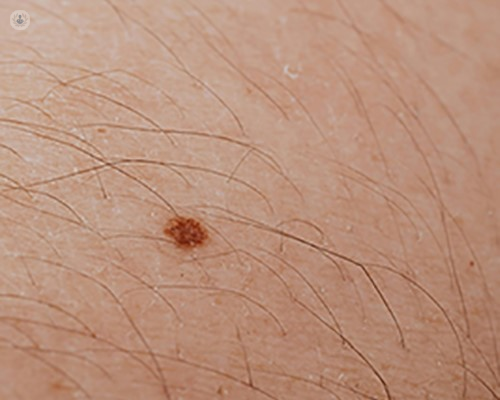Key FAQs about melanoma
Written in association with:Melanoma is a skin cancer arising from pigment cells in the skin that can be life-threatening if not caught early. In her latest article, Dr Christina Leitner gives us her insights.

What is melanoma?
Melanoma develops in pigment-producing cells (melanocytes) of the skin. The pigment gives your skin its colour. Melanomas can arise from existing moles (an accumulation of pigment cells in the skin) or from normal skin. Melanomas can be life-threatening as they can spread to other parts of the body. Early detection of melanomas is vital to improve survival by preventing the spread.
The incidence of melanoma has been steadily rising over the past few decades. According to Cancer Research UK, 17,500 new melanoma cases were diagnosed in the UK every year between 2017 to 2019, on average 48 every day. Since the 1990s, melanoma skin cancer incidence rates have increased by 140%. This increase in cases highlights the importance of awareness and early detection.
Gender differences in melanoma
Approximately 8,000 men are diagnosed with melanoma annually in the UK. More men are diagnosed with melanoma over the age of 50 than women. Similarly, around 8,000 women are diagnosed each year. However, women under the age of 50 are more likely to be diagnosed with melanoma than men of the same age.
Common locations of melanomas on the body
The location of melanomas can vary between men and women. In men, melanomas are most commonly found on the trunk (chest and back), whilst women are more likely to develop melanomas on their legs.
However, it is essential to check all areas of the skin, including less obvious places like the scalp, soles of the feet, nails and the genitals.
Factors that increase the risk of melanoma
Several factors can increase the risk of developing melanoma, including:
- Exposure to UV radiation: This is the most significant risk factor. UV radiation from the sun and tanning beds can damage the DNA in skin cells, leading to cancer.
- Moles: More than 100 moles, amongst them atypical moles (unusual shape, various colours, more than 8mm in size) or giant pigmented birth marks of more than 20cm in diameter increase the risk.
- Fair skin: Individuals with fair skin, freckles, red or blonde hair, and light-coloured eyes are at higher risk.
- Family history: A family history of melanoma can significantly increase the risk.
- Personal history: If you have had melanoma before, you are at higher risk of developing another melanoma.
- Weakened immune system: Individuals with weakened immune systems are at increased risk.
The importance of early detection
Early detection of melanoma can dramatically improve survival rates. When melanoma is detected and treated early, before it has spread to other parts of the body, the prognosis is excellent. Here are some key statistics highlighting the importance of early detection:
With early detection of a melanoma, the 5-year survival rate is about 85 -100%. Early-stage melanomas are typically localised in the skin and can often be treated effectively with surgery.
If a melanoma has spread to distant lymph nodes (glands of your immune system) the survival rate is 75%, if it spreads to other parts of the body, the 5-year survival rate drops to 30%.
How to check for melanoma
Regular skin checks can help detect melanoma early. Here are some tips for effective skin self-examinations.
Check your entire body, including hard-to-see areas like the back, scalp, and soles of the feet. Look for asymmetry, border irregularity, colour variation, diameter (progressive enlargement over weeks to months). This is not valid for atypical moles.
Take photos of moles to monitor changes over time. This is especially useful for atypical moles. Visit a dermatologist regularly for professional skin checks, especially if you are at higher risk.
Reference
Cancer Research UK, http://cancerresearchuk.org/health-professional/cancer-statistics/statistics-by-cancer-type; Accessed June 2024
Dr Christina Leitner is an esteemed dermatologist. You can schedule an appointment with Dr Leitner on her Top Doctors profile.


